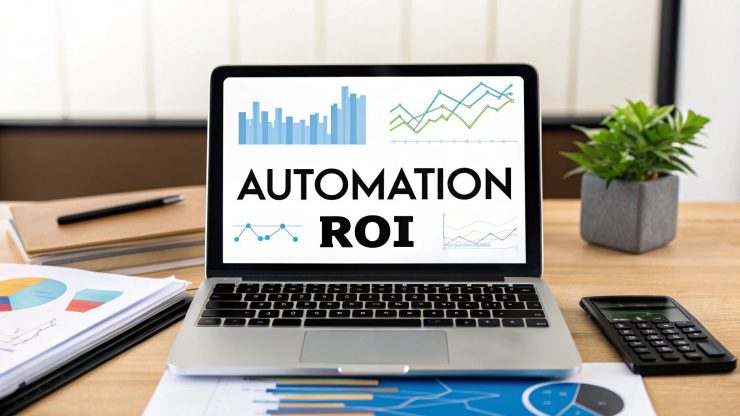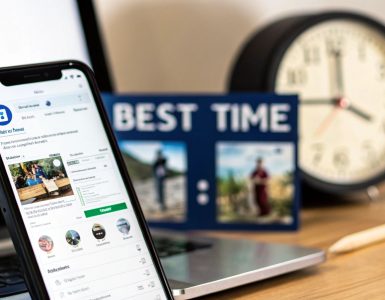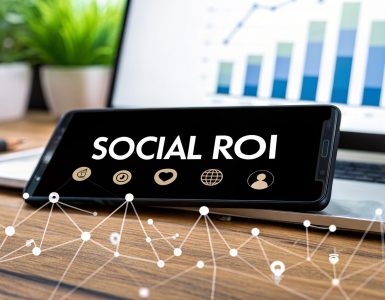So, you’re using marketing automation, but is it actually making you money? That's the million-dollar question, and calculating your marketing automation ROI is how you get the answer. It cuts through the vanity metrics to show you the cold, hard cash your platform is generating for every dollar you put in.
Think of it as the ultimate report card for your marketing's financial health.
Understanding Your Marketing Automation ROI

At its heart, the idea is simple. You're comparing the financial gains you’ve made from your automation efforts to what you spent to get there. But the real power comes from looking at the complete picture. This isn't just about your software subscription; it’s a full accounting that includes everything from staff hours to the cost of creating campaign assets.
The biggest mental shift is to stop seeing automation as just another monthly expense. When you set it up right, it's a strategic investment. It becomes a tireless digital employee, working around the clock to nurture leads, close deals, and make every penny of your marketing budget work harder.
The Two Sides of the ROI Coin
To really get a handle on your marketing automation ROI, you need to break it down into two sides of the same coin: the return you're getting and the investment you're making. Getting a clear view of what falls into each bucket is the only way to get a number you can trust.
The Return: Where the Gains Come From
This is the tangible value your automation platform creates. It's not just one thing; it’s a combination of direct revenue and saved costs.
- Increased Revenue: This is the most obvious part—the sales you can directly attribute to your automated campaigns. Think about revenue from abandoned cart emails, lead nurturing sequences that finally convert a prospect, or targeted upsell offers.
- Cost Savings: This is the "hidden" gain. How much are you saving because your team isn't manually sending follow-up emails? Or because your customer acquisition cost dropped? That's real money back in your pocket.
The Investment: What You're Actually Spending
This covers every single cost associated with getting your automation machine running smoothly.
- Software Fees: The straightforward one—your monthly or annual subscription fee for the platform.
- Implementation & Training: Don't forget the one-time setup costs and, more importantly, the hours your team spends getting up to speed. Their time is money.
- Content & Campaign Creation: Every email, landing page, and workflow took time and resources to build. Those costs are part of your total investment.
To help visualize this, here's a quick breakdown of the core components:
Marketing Automation ROI Components at a Glance
| Component Type | Key Metrics to Track | Business Impact |
|---|---|---|
| Return | Attributed Revenue, Sales Qualified Leads (SQLs), Customer Lifetime Value (CLV) | Directly measures revenue growth and the quality of leads generated. |
| Return | Time Saved on Manual Tasks, Reduced Customer Acquisition Cost (CAC) | Boosts operational efficiency and improves overall marketing profitability. |
| Investment | Software Subscription Fees, Initial Setup Costs | Represents the direct, fixed costs of the automation platform. |
| Investment | Employee Training Hours, Time Spent on Campaign Creation & Management | Accounts for the "soft" costs of human resources needed to run the system. |
This table simplifies how to categorize your efforts and expenses, making the final calculation much more accurate.
And the potential return is nothing to sneeze at. Research has shown that companies can see an average return of $5.44 for every $1 spent on marketing automation within three years. That’s a massive impact on the bottom line. You can dig into the numbers in this detailed report on marketing automation profitability.
When you clearly define and track these components, you move marketing from a "cost center" to a proven revenue driver. You'll know exactly where your money is going and, more importantly, what it’s bringing back.
How to Calculate Your Marketing Automation ROI
Figuring out the ROI on your marketing automation doesn't take a PhD in finance. At its heart, it’s a pretty simple comparison: what did you make versus what did you spend? Once you get a handle on each piece of the equation, you can build a solid framework to see exactly what your investment is bringing back to the business.
The core formula is straightforward:
(Financial Gain – Investment Cost) / Investment Cost = ROI
The number you get is usually shown as a percentage and tells you the return for every dollar you put in. For instance, an ROI of 400% means you got $4 back for every $1 you spent. But remember, the value of that final number is only as good as the data you feed it.
This process breaks down the core steps you need to follow to get an accurate picture of your return.
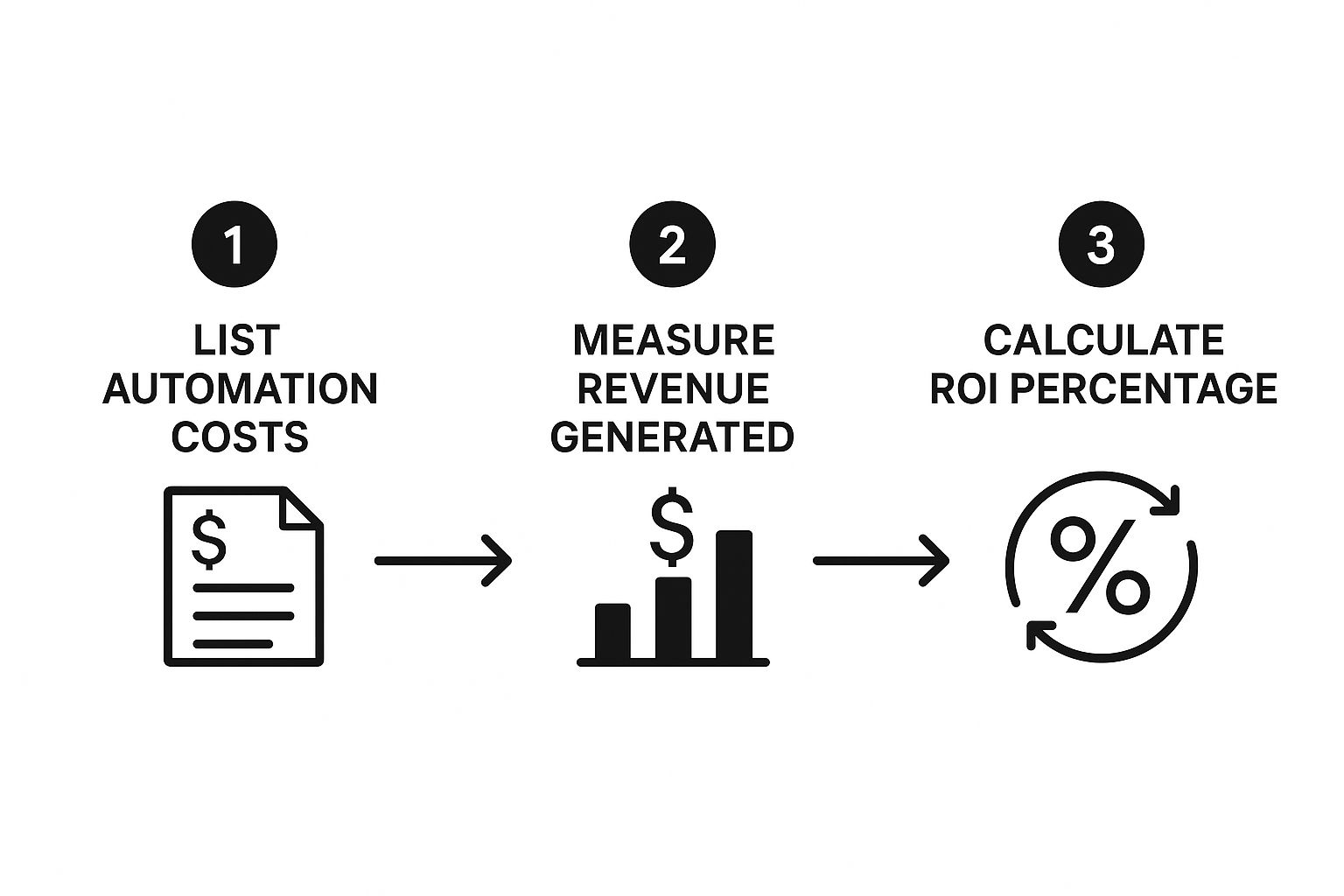
As you can see, a clear, step-by-step approach—from adding up your costs to measuring your gains—is the only way to arrive at a calculation you can trust.
Step 1: Tally Your Total Investment Cost
First things first, you need to get a clear picture of what you're actually spending on marketing automation. This goes way beyond the monthly subscription fee you see on the invoice. To get the real cost, you have to look at everything involved.
Make sure your list includes these items:
- Software and Platform Fees: This is the obvious one—the monthly or annual bill for your automation tool.
- Implementation and Setup: Did you have to pay a one-time fee to get started or migrate your data? That counts. Any cost to get the platform up and running needs to be included.
- Team Hours and Training: This is a big one, and it's so easy to overlook. Think about the time your team spends in training, building campaigns, creating workflows, and just managing the system. Their time is a direct investment, so you need to account for it.
- Content Creation: You also need to factor in the cost of creating all the assets that power your automation, like email copy, landing page designs, and lead magnets.
Adding up all these direct and indirect expenses gives you the "Investment Cost" for your ROI formula.
Step 2: Measure Your Financial Gain
Now for the fun part: figuring out the value your automation platform has generated. This "Financial Gain" really comes from two main places—straight-up revenue increases and operational cost savings. The trick here is attributing that revenue correctly.
Direct Revenue Attribution is your clearest win. This is new money you can confidently trace back to an automated campaign. For example, if an abandoned cart email series recovered $5,000 in lost sales and a lead nurturing sequence brought in $15,000 from once-cold leads, your directly attributed revenue is $20,000.
Getting your marketing automation ROI right often comes down to having solid attribution models. Digging into concepts like Salesforce Marketing Attribution can really open your eyes to how different touchpoints work together to drive a sale. This helps you see which automated interactions are pulling the most weight.
Beyond direct sales, don't forget these other financial gains:
- Increased Customer Lifetime Value (CLV): Automated campaigns for upselling, cross-selling, and keeping customers happy can seriously boost how much each customer spends with you over time.
- Efficiency and Cost Savings: This is a huge, tangible benefit. Calculate the hours your team got back by automating tasks they used to do by hand. If automation saves your team 20 hours a month and your blended hourly rate is $50, that’s a $1,000 monthly saving right there.
Step 3: Put It All Together with an Example
Let's walk through a realistic scenario for a B2B company looking at its results over a single quarter.
-
Total Investment Cost:
- Software Fee: $1,500 ($500/month x 3)
- Team Hours (40 hours @ $50/hr): $2,000
- Content Creation: $500
- Total Cost = $4,000
-
Total Financial Gain:
- Revenue from Nurtured Leads: $15,000
- Time Saved (60 hours @ $50/hr): $3,000
- Total Gain = $18,000
Now, we just plug these numbers into our trusty formula:
($18,000 – $4,000) / $4,000 = $14,000 / $4,000 = 3.5
To turn that into a percentage, just multiply by 100. The marketing automation ROI is 350%. In plain English, this means for every dollar they invested, the company generated $3.50 in return. Not bad at all.
The Key Metrics That Drive Your ROI

To really get a handle on your marketing automation ROI, you have to look under the hood at the engine that drives it. While the final ROI percentage tells you if you're winning, a few key performance indicators (KPIs) are the individual gears making it all happen. These aren't just numbers on a screen; they're the levers you can actually pull to boost your bottom line.
Knowing what these metrics are is the difference between just having automation and using it strategically. When you know which numbers matter, you can finally connect your team's day-to-day work—like building an email workflow or tweaking a landing page—to real, tangible results. It lets you focus your energy and budget on what truly moves the needle.
Lead Conversion Rate
This is one of the big ones. Your lead conversion rate is simply the percentage of leads who do what you want them to do. That could be signing up for a demo, making a purchase, or becoming a sales-qualified lead (SQL). The higher this number, the more value you're squeezing from the leads you already have, which pumps up the "Financial Gain" side of your ROI calculation.
Marketing automation is a total powerhouse for improving this metric. With automated lead nurturing, you can send the right content at the right time, guiding people along their journey. Instead of leads going cold, automation keeps the conversation alive, builds trust, and inches them closer to a sale. Even a small 1% bump in your conversion rate can have a massive ripple effect on revenue, all without spending another dime on ads.
Customer Acquisition Cost (CAC)
Next up is your Customer Acquisition Cost (CAC). This metric tells you, on average, exactly what you're spending to land one new customer. The lower your CAC, the more efficient your marketing and sales machine is—and the better your ROI. The name of the game is to spend less to get more.
This is where automation really shines. By automating all those repetitive tasks, you free up your team's time and lower your "Investment Cost." But it goes deeper. Smart lead nurturing and scoring also ensure your sales team only talks to the hottest, most qualified prospects. That efficiency means they can close more deals with less effort, which directly pushes your CAC down.
One of the most powerful things about automation is how it boosts gains while cutting costs at the same time. The impact on lead generation and conversion is especially strong. In fact, research shows automation can lead to an 80% increase in leads and a 77% jump in conversions. You can dig into more of these stats in this rundown of marketing automation statistics.
Customer Lifetime Value (CLV)
Finally, there’s Customer Lifetime Value (CLV). This metric projects the total amount of money you can expect to earn from a single customer over the entire time they do business with you. Growing your CLV is one of the most sustainable ways to build your company because keeping a customer is almost always cheaper than finding a new one.
Marketing automation is fantastic for building stronger, longer-lasting customer relationships. Think about it:
- Smart Onboarding: An automated welcome series helps new customers get value from your product right away, which dramatically cuts down on early cancellations.
- Upsell & Cross-sell Plays: By tracking how customers use your product, you can automatically trigger perfectly timed offers for upgrades or related products.
- Loyalty Campaigns: Automated check-ins, special offers for long-time fans, and feedback requests make customers feel seen and appreciated, giving them little reason to leave.
By keeping your eye on these three core metrics—Lead Conversion Rate, CAC, and CLV—you get a much richer picture of your marketing automation ROI. You can see exactly how your automated systems are making an impact, which lets you fine-tune your strategy for maximum financial return.
So, you've crunched the numbers and have your marketing automation ROI. The big question now is, "Is this any good?"
The honest answer? It depends. There’s no universal magic number. What’s considered a fantastic marketing automation ROI in one industry might be just average in another. Think of it like a car's fuel efficiency—what's impressive for a massive truck would be a real letdown for a zippy little compact car.
Your business context is everything. Things like your average deal size, how long it takes to close a sale, and your overall business model all have a huge say in what a "good" ROI looks like for you. An ecommerce shop with a fast sales cycle will see a different kind of return than a B2B software company that spends months nurturing its leads.
Setting Realistic Benchmarks
To figure out if your ROI is on track, you need to compare it to industry averages. This gives you crucial context, helping you set goals that are ambitious but achievable. It also helps you manage expectations with your boss or stakeholders and pinpoint where you're excelling or falling behind your peers. Without these benchmarks, your ROI is just a number floating in a void.
Knowing where you stand transforms that number from a simple metric into a powerful story about your performance. It tells you how efficient and effective you are compared to the competition. A high ROI can be a huge validation of your strategy, while a lower one is really just a signpost showing you where you can tune things up.
There's a reason the entire marketing automation industry is booming—it just plain works. The market is expected to grow at an annual rate of 15.3%, hitting an estimated $15.62 billion by 2030. This isn't just hype; it's driven by real demand. In fact, 91% of business leaders report more requests for automation from their teams, especially since AI now drives about 77% of personalized content creation. You can dive deeper into these marketing automation industry statistics if you're curious.
This massive adoption just goes to show the value and proven returns companies are getting everywhere.
Average Marketing Automation ROI by Industry
To give you a clearer picture, let’s look at some typical ROI figures across different sectors. The table below offers a comparative look, helping you benchmark your own performance against what's common in your field. Understanding these differences is key to fairly judging your own success.
Average Marketing Automation ROI by Industry
A comparative look at typical ROI figures, helping businesses benchmark their performance against industry averages.
| Industry Sector | Average Reported ROI | Key Contributing Factors |
|---|---|---|
| B2B SaaS | 300% – 600% | Long sales cycles get a huge boost from automated lead nurturing; high customer lifetime value (CLV) makes the investment a no-brainer. |
| Ecommerce | 400% – 800%+ | High-impact tactics like abandoned cart emails and personalized product recommendations deliver quick, easily measured returns. |
| Professional Services | 200% – 500% | Automation helps build credibility and nurture client relationships over the long haul, turning warm leads into high-value contracts. |
| Healthcare | 250% – 550% | Patient communication, appointment reminders, and educational campaigns drive up engagement while improving operational efficiency. |
As you can see, the returns are substantial pretty much everywhere, but the scale and speed can differ. An ecommerce brand can often tie a specific email to a direct sale, while a B2B firm's ROI is built up slowly through consistent nurturing. These benchmarks often reflect a combined marketing effort, too. If you need to zoom in on the performance of a specific channel, our guide on how to measure social media ROI can help you get more granular with your calculations.
Ultimately, a good marketing automation ROI is one that not only blows past your initial investment but also keeps climbing over time. It should be a clear signal of growing efficiency, deeper customer connections, and a real, positive impact on your company's bottom line.
Proven Strategies to Maximize Your ROI
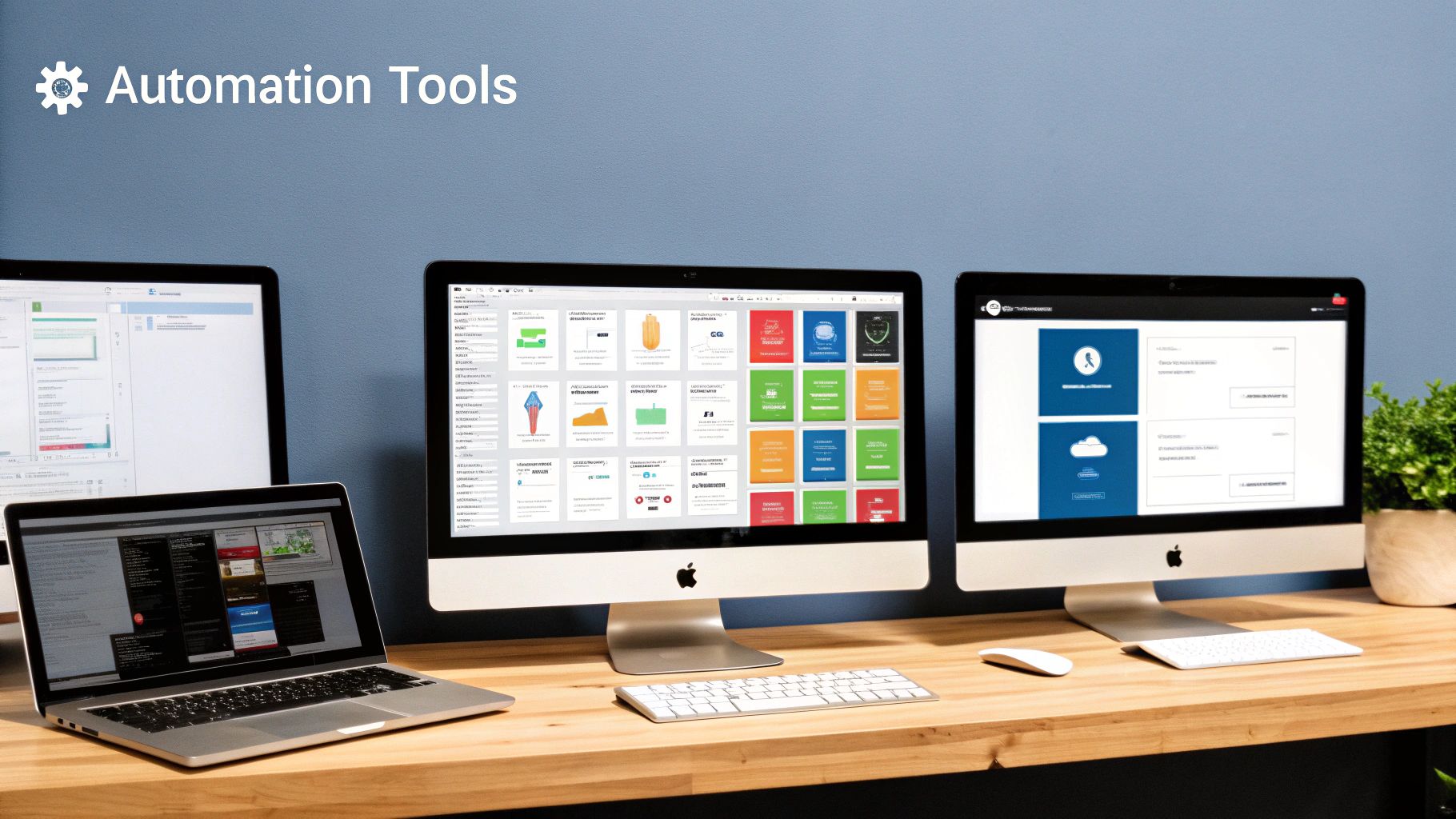
Knowing your marketing automation ROI is a great first step, but improving it is where the real magic happens. Moving from calculation to action is how you truly get the most out of your investment. Simply plugging in an automation platform won't cut it—you need a solid game plan to squeeze every last drop of value from it.
These aren't just theories; they're battle-tested tactics for amplifying your returns. By refining your approach and using your assets more intelligently, you can turn a decent marketing automation ROI into an exceptional one. The goal is to build a system that not only runs itself but consistently gets smarter and more efficient.
Master Advanced Segmentation
Let's be honest: generic, one-size-fits-all marketing is an ROI killer. The real wins are in personalization, and that journey begins with smart segmentation. It's time to move beyond basic demographics and start grouping your audience based on what they do.
Think about segmenting by:
- Website Behavior: Group people who have checked out your pricing page but haven’t yet signed up.
- Purchase History: Create different lists for your brand-new customers versus your loyal, repeat buyers.
- Engagement Level: Separate your super-fans who open every email from the subscribers who have gone quiet.
When you get this granular, you can send hyper-relevant messages that actually resonate. A prospect who has viewed your pricing page three times needs a completely different conversation than someone who just downloaded their first ebook. This kind of focused targeting is a direct line to better conversion rates, pushing the "gain" side of your ROI equation way up.
Implement a Robust Lead Scoring Model
Not all leads are created equal, and your sales team’s time is precious. A lead scoring model is your secret weapon for helping them focus only on the opportunities most likely to close. This alone can dramatically improve their efficiency and your bottom line.
Here’s how it works: you assign points to leads based on who they are and the actions they take.
- Demographic Fit: Is the lead from a target industry with the right job title? That could be +10 points.
- High-Intent Actions: Requesting a demo is a huge buying signal, earning them +20 points.
- Engagement: Simply visiting the pricing page might add +5 points.
Once a lead hits a predetermined score—say, 100 points—they are automatically flagged as a "Sales Qualified Lead" (SQL) and sent straight to a salesperson. This system stops your sales team from wasting time on lukewarm prospects and lets them pour all their energy into closing deals. To really nail this, consider adopting proven marketing automation best practices that successful teams rely on.
Unleash the Power of Content Automation
One of the most overlooked ways to boost your marketing ROI is to get more mileage out of the content you already own. You've invested time and money creating fantastic blog posts, case studies, and guides. Letting them get one burst of traffic before they fade into the archives is a massive waste of potential.
This is where social media automation tools become incredibly powerful.
Think of your best content as a valuable asset that can generate returns indefinitely. Instead of a one-time promotion, automated re-sharing turns your evergreen content into a perpetual lead-generation engine.
Platforms like EvergreenFeed are built for exactly this. You can load your best evergreen content into different "buckets" and set a schedule to automatically re-share those posts across your social channels. This keeps your feed active and valuable without constant manual effort.
This simple tactic drives a continuous, predictable stream of traffic back to your site, captures new leads, and nurtures your audience—all from work you've already done. It's a high-leverage move that adds directly to your financial gain with almost no extra investment. To see how this fits into a bigger picture, you can learn more from our own guide to marketing automation best practices.
Relentlessly Optimize with A/B Testing
Finally, never settle. Your first draft of a campaign is just a starting point, not the final word. Automated A/B testing is your key to continuous improvement and finding what truly works.
Get in the habit of testing everything:
- Email Subject Lines: Which version gets more opens?
- Calls-to-Action (CTAs): Does "Get a Demo" convert better than "Start Your Trial"?
- Landing Page Headlines: Which message makes a stronger connection with your audience?
By constantly running these small experiments, you'll uncover insights and make incremental gains. Over time, those small wins add up to a significant impact on your conversion rates and, ultimately, your overall marketing automation ROI.
Real-World Examples of High ROI Automation
Formulas and theory are one thing, but seeing marketing automation work its magic in the real world is another. Let’s look at how actual companies have turned these concepts into serious cash.
These stories aren't just abstract case studies. They're practical blueprints showing what happens when a smart strategy meets the right tech, transforming everyday challenges into huge financial wins.
The Ecommerce Brand Recovering Lost Sales
Picture an online fashion store with a classic, frustrating problem: abandoned carts. For every ten shoppers adding items to their cart, four were clicking away without buying anything. That’s thousands of dollars in potential revenue vanishing every single day.
Their solution? A simple but incredibly effective abandoned cart workflow.
- The Gentle Nudge: 60 minutes after a cart was abandoned, an automated email went out, gently reminding the shopper what they’d left behind.
- The Sweetener: If 24 hours passed with no action, a second email landed in their inbox, this time with a 10% discount to seal the deal.
- The Last Chance: A final reminder after three days created a little urgency, putting the products in front of them one last time.
The results were almost instant. The automated sequence recovered over 20% of previously lost sales, which translated to an extra $15,000 in revenue in the first month alone. This is a perfect example of a small, targeted automation delivering a massive, easily measured return.
The secret sauce here is that nurtured leads make 47% larger purchases than those who aren't nurtured. By tackling the specific issue of cart abandonment, the company didn't just plug a leak; they created a reliable new revenue stream.
The B2B Firm Slashing Its Sales Cycle
Now, let's switch gears to a B2B software company. They were dealing with a painfully long sales cycle that often stretched past six months. Their sales team was spinning its wheels chasing lukewarm leads, while the hottest prospects weren't getting the attention they deserved.
To fix this, they rolled out an intelligent lead nurturing and scoring system. Prospects automatically earned points for taking actions like visiting the pricing page or downloading a case study. Once a lead's score hit a certain threshold, they were flagged as "sales-ready" and handed off to the sales team.
This completely changed the game. The sales reps stopped wasting time on unqualified leads and could pour all their energy into prospects who had already shown clear buying signals.
This laser focus, all powered by automation, cut their average sales cycle by a full third—from six months down to just four. Not only did this bring in revenue faster, but it also freed up the sales team to close more deals, boosting their overall efficiency and ROI. These examples show that you don't have to be a massive enterprise to get these kinds of results. In fact, exploring small business marketing automation provides a fantastic roadmap for companies of any size to start seeing similar returns.
Common Questions About Marketing Automation ROI
Even with a solid plan, it's natural to have questions before diving into something new. Let's walk through some of the most common sticking points people have about marketing automation ROI. Getting these practical details sorted out can mean the difference between a confident investment and a hesitant one.
How Long Until I See a Positive ROI?
This is the big one, isn't it? The honest-to-goodness answer is: it depends. That said, most businesses start seeing a positive marketing automation ROI within 6 to 12 months. Some studies even show that 44% of companies get there in the first six months.
What separates the fast movers from the rest? It usually comes down to a few things:
- Data Quality: Starting with a clean, organized contact list is a massive head start. If your data is a jumbled mess, your first few months will be spent on cleanup duty, not generating returns.
- Strategy Clarity: Just buying software without a plan is a recipe for a slow, frustrating journey. A clear strategy for how you'll nurture leads and segment your audience from day one will dramatically speed things up.
- Team Adoption: A powerful tool is useless if nobody knows how to use it. How quickly your team gets comfortable and actively uses the platform directly affects how fast you see results.
Is Marketing Automation Worth It for a Small Business?
Absolutely. It’s a common myth that automation is just for giant corporations with bottomless budgets. These days, there are tons of affordable, scalable tools built specifically for smaller, nimbler businesses.
In fact, the impact is often even bigger for a small business. Automation lets a small team punch well above its weight, taking care of tasks that would normally require several new hires. By automating things like lead follow-ups and social media, you can go toe-to-toe with bigger competitors without the enterprise-level costs.
What Are the Biggest Mistakes That Hurt My ROI?
Sometimes, knowing what not to do is just as important. The fastest way to sink your marketing automation ROI is to stumble into a few all-too-common traps. Steer clear of these pitfalls:
The biggest mistake is launching without a strategy and expecting the software to be a magic wand. Automation is a tool, not a standalone solution. Its power is entirely unlocked by the strategy behind it.
Here are the top offenders we see time and again:
- Poor Data Hygiene: Working with outdated or messy data is like pouring expensive gasoline into a car with a hole in the tank. You're just wasting valuable resources.
- Ignoring Sales Alignment: If marketing is busy generating leads that the sales team can't use or doesn't follow up on, the whole system breaks down. That investment goes right down the drain.
- Setting It and Forgetting It: Automation isn't a crockpot. Your campaigns need regular check-ins and tweaks. A workflow that was crushing it last quarter might need a refresh to stay effective.
Ready to put your content on autopilot and squeeze every drop of ROI from it? EvergreenFeed automates your evergreen social media posts, driving continuous traffic and leads from the amazing content you've already created. Stop letting your best work collect dust. Start your free trial today.

